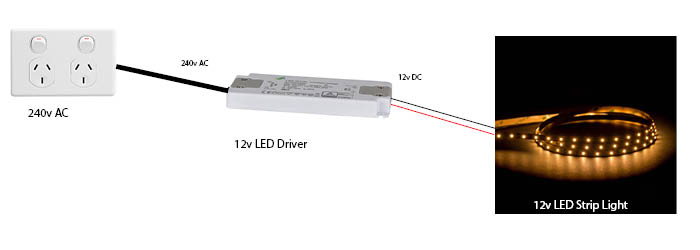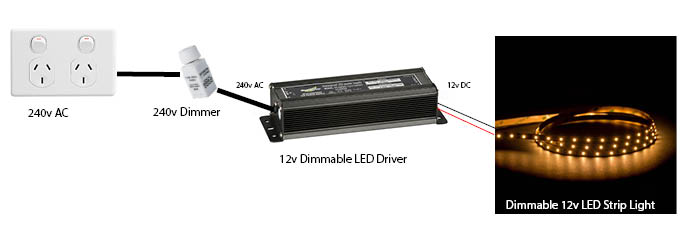What are LED stirp lights?
LED strip lights are a new flexible and versatile type of lighting that is made from a flexible circuit board populated by surface mounted LED’s. The amount of LED’s now various depending on the light output required or length of strip. LED strip lights can have anywhere from 30 LED’s/metre to over 250 LED’s/metre.
Why use LED strip lights?
LED strip lights are very slim and can be installed over long runs, making them very practical for certain lighting locations that weren’t traditional accessible with traditional halogen lamps.
LED strip lights can be used for accent lighting, backlighting, decorative lighting, task lighting or a combination of these if using dimmers or RGB LED strip lights.
Where are LED strip lights installed?
LED strip lights are installed almost everywhere you go, from residential houses to commercial buildings, you will see strip lights used both inside and outside. We have even seen strip lights used in council walkways and parks.
Common locations for LED strip lights:
- Kitchen under bench lighting
- Kitchen under island bench lighting
- Bulkhead lighting
- Cabinet & shelving lighting
- Handrail lighting
- Stair lighting
- Bathroom accent lighting
- Outdoor accent lighting
- Bar and Restaurant lighting
- Retail product display lighting
- Retail storefront lighting
What parts do I need for LED strip lights?
LED strip lights only require a few products to operate:
1. LED Strip Light
The first thing required is an LED strip light. All Lights2you LED strip lights come with an adhesive backing for installation
2. Power Supply
LED strip lights require a power source to operate as they cannot be connected directly to a power point with 240v AC power. Most LED strip lights require lower, 12v or 24v DC voltage to operate and this is obtained through a converter (LED Driver) which reduces 240v down to a 12v or 24v voltage. The required voltage will depend on the strip light selected.
3. Heat Sink or Channel
This is not essential but highly recommended. All LED strip lights will generate heat and do require a high dissipating surface, such as aluminium, to help reduce the increase in operating temperature and deterioration of the LED circuit board. Aluminium heat sink or aluminium channels are common choices.
Browse Heat Sink & Aluminium Channels
How to select the correct LED strip light?
There are four main factors to look at when selecting the correct LED strip light:
- Wattage
- Light Colour
- Weatherproof rating
- Voltage
To select the correct LED strip light, you first need to know what your trying to achieve with the light. Do you want to subtle accent lighting, decorative lighting, or bright task lighting. Once you know the objective, you can then select the wattage of a strip light. The wattage is related to the brightness, a 4.8w/m LED strip light is a great accent light compared to a bright 24w/m LED strip light which is 5-6 times brighter.
The second factor to consider is the light colour. LED strip lights come in various white lights, warm white, cool white, day light. They also come in colours or versions of RGB, multi-colour lights. RGB strip lights are now also available as 2in1 models, with RGB-W and RGB-C now available, giving the options for colours or a white for different lighting requirements.
The next factor to consider is the location, is the strip light being installed inside or outside? Is the strip light being installed in a wet area?
LED strip lights from lights2you are available with silicon coatings making them weatherproof (IP54) or waterproof (IP67) if required for your location.
The last factor to consider is the voltage, strip lights are available in both 12v or 24v options. If you are restricted to a certain voltage, using existing power, then you will have to select a corresponding voltage. If you are starting a new project, you simply need to purchase a corresponding LED driver to match your selected LED strip light.
What is the maximum length of LED strip light?
The maximum length will vary on the model, most LED strip lights have a max length of 5m. Lights2you does also offer new long run LED strip lights that have a max length of 10m.
LED strip lights can be made to appear much longer than their maximum lengths by installing multiple strip lights together, creating light effects over 10m long. Please consult a Lights2you salesperson for more information.
Browse long run 24v LED strip lights
Are LED strip lights dimmable?
All LED strip lights can be made dimmable, they do however require the correct components and there are various ways to dim an LED strip light.
Basic configuration of LED strip lights is with a non-dimmable LED driver connected to a 240v AC power supply on one side with the LED stirp connected to the 12v/24v output.

Option 1: Dimming on 240v AC side:
You can purchase dimmable LED drivers which allow the use of standard 240v dimmers that are used with many other LED lights.

Advantages: Easy to connect and install
Disadvantage: Dimming range is between 25% - 100%. Some dimmers may go below 25% but encounter flickering.
Option 2: Dimming on Low Voltage side:
Using the initial configuration for an LED stirp light, additional components can be purchased and used to dim on the low voltage side.
0-1/10v Dimming controller can be purchased along with compatible 0-1/10v Dimming dial:
Image 3

0-1/10v Dimming controller with wireless remote control can be purchased.
New Smart controllers now available, compatible with wireless mobile apps.

How to control RGB LED Strip Lights?
If you purchase an RGB LED strip light or newer version such as an RGBW or RGBC LED strip light, you will need additional components to control the functions. There are now three methods to control LED strip lights:
1. Wireless Multifunction Remote Controller:
This is the simplest way to control any LED strip lights, whether it be dimming a single colour strip light or a varying RGB colour LED strip light. The remote control speaks to a receiver that is connected just before the LED Strip light.
2. Wall Panel:
The next option is to control a strip light through a wall control unit. Wall control units can be hard wired or wireless, wireless will act like a remote but be installed permanently on an adjacent wall.
A hard wired wall control is more reliable than a remote as it doesn’t rely on batteries and sending signals over air waves. A hard wired wall control will take longer to install and in some cases cannot be installed if no cable is able to joined to an LED strip light.
3. Smart Wifi Controller:
Smart controllers are constantly being developed and improving a fast rate. To control an RGB strip light through an app or mobile device, new controllers can be purchased and can be connected directly to mobile apps or though additional devices light a Phillips Hue bridge which allows it to then be connected to more mobile apps.
Browse new smart LED controllers
Lights2you Recent Projects with LED Strip Lights:
RGBC LED Strip Light supply and installation in ceiling Bulkheads:
Lights2you recently complete a project with RGBC LED strip lights used in multiple ceiling bulk heads for colourful ambient lighting, all controlled through the latest Zigbee wireless remotes.
View the project through our video here:
Mount Vernon Project:

Warm white LED strip lights supply in ceiling bulkheads, under kitchen cupboards, bathroom ceilings, vanities, shelving and niches:
A recent project in conjunction with SBR Group, local custom building group, who came to us to complete the customers requirements of LED strip lights in many bulkheads, al ranging with different ceiling heights, and wanting a lovely consistent warm white flow throughout the house.
SBR group also had many bathrooms that require LED strip lights for indirect, ceiling lighting, vanity mirror lighting and also multiple custom marble niche lighting.
To view the project, please take a 3D walk through tour checking out all the lovely effect:
SBR Pemulwuy Project:


